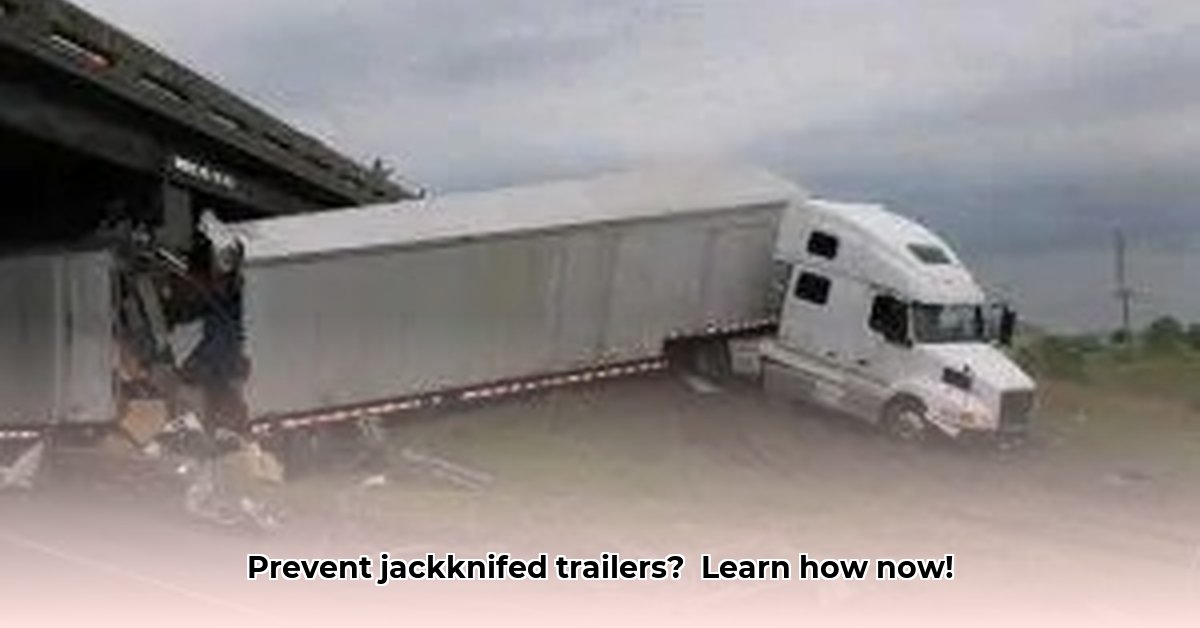
Jackknifing—the terrifying scenario where your trailer swings out, forming a dangerous "L" shape—is a significant threat in trucking. This guide details why jackknifing occurs and, more importantly, how to prevent it. Preventing these accidents isn't just about avoiding costly repairs; it's about saving lives and ensuring safer roads for everyone. For more information on connecting your tractor and trailer correctly, see this guide on tractor trailer hooking.
Understanding Why Tractor Trailers Jackknife
A jackknife occurs when the trailer pivots sharply around the kingpin (the connection point between the tractor and trailer). This often results from a sudden loss of traction, triggered by various factors. Think of it like a powerful dog pulling hard on its leash—a sudden pull can cause a dramatic shift.
Several contributing factors significantly increase the likelihood of jackknifing:
- Braking Issues: Harsh braking, especially on curves or slippery surfaces, causes the trailer to continue moving forward, leading to the jackknife.
- Weight Distribution: Unevenly loaded trailers shift their center of gravity, resulting in instability and increased risk.
- Mechanical Problems: Faulty brakes, worn tires, or damaged suspension systems reduce stability and control.
- Road Hazards: Adverse weather conditions like rain, ice, snow, or leaves significantly reduce traction.
Preventing a Jackknife: Actionable Steps for Truckers
Preventing jackknifing requires proactive measures and adherence to safe driving practices. These aren't just suggestions; they're essential safety protocols.
1. Master Smooth Braking Techniques:
- Gentle Application: Avoid harsh braking. Apply brakes gradually and smoothly, especially on curves or slippery surfaces.
- Proactive Observation: Scan the road ahead, anticipating potential hazards like stopped traffic or changes in road surface. Adjust your speed proactively.
- Engine Brake Usage: Use engine brakes judiciously. They are less effective on wet or icy roads.
2. Achieve Optimal Cargo Load Distribution:
- Even Weight: Distribute weight evenly across the trailer. An unevenly loaded trailer is significantly more prone to instability.
- Secure Cargo: Secure all items tightly to prevent shifting during transit. Loose cargo can drastically alter the center of gravity.
- Adhere to Weight Limits: Never exceed weight limits. Overloading dramatically increases the risk of jackknifing.
3. Prioritize Vehicle Maintenance:
- Regular Inspections: Conduct thorough and routine inspections of brakes, tires, and suspension systems. Early detection of problems is crucial.
- Tire Pressure: Maintain proper tire inflation for optimal traction.
- Brake System Checks: Check your brakes, including ABS, before each trip to ensure everything is functioning perfectly.
4. Practice Defensive Driving Techniques:
- Safe Following Distance: Maintain a safe following distance, especially in adverse weather. Increased distance provides more reaction time.
- Appropriate Speed: Adjust your speed to match road conditions. Slower speeds often mean greater safety, particularly in challenging situations.
- Situational Awareness: Pay constant attention to your surroundings—other vehicles, road conditions, and potential hazards.
5. Leverage Modern Safety Technologies:
- Advanced Safety Systems: Utilize advanced systems like Electronic Stability Control (ESC) and Advanced Emergency Braking Systems (AEBS) to enhance stability and safety. These systems can significantly reduce the likelihood of jackknifing.
Road Conditions and Their Impact
Adverse weather significantly impacts traction and increases the risk of jackknifing. Heavy rain, ice, snow, or leaves on the road dramatically reduce your vehicle's control. Reduce speed, increase following distance, and modify driving behavior to account for reduced traction.
The Human Factor: Training and Experience
Driver training is paramount. Regular refresher courses focusing on skid control and emergency procedures enhance driving skills and preparedness for challenging driving conditions. These skills are essential for mitigating risks and preventing accidents.
Working Together for Safer Roads
Preventing jackknifed trailers is a collaborative effort. Truckers, fleet managers, regulatory bodies (like the FMCSA), and trailer manufacturers all share responsibility for fostering safer roads. Improved driver training, enhanced vehicle maintenance, better road infrastructure, and continued investment in advanced safety technologies all contribute to a safer transportation environment.
Key Takeaways: Preventing Jackknifing
- Gradual braking is essential, especially on curves and inclines.
- Maintaining a sizable following distance is crucial for reaction time.
- Understanding and adapting to adverse conditions are key.
- Regular vehicle maintenance (tires, brakes, suspension) is non-negotiable.
- Driver training and experience significantly influence safety outcomes.
- Advanced safety technologies like ABS and ESC enhance vehicle stability.
- Load management is critical for preventing trailer instability.
"Regular driver training is crucial for mitigating jackknifing incidents. We focus on proactive measures, emphasizing safe driving techniques and advanced emergency maneuvers," says Dr. Emily Carter, Director of Driver Safety, National Trucking Association.